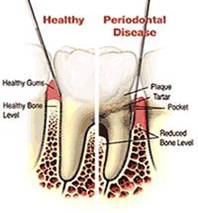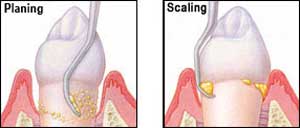
Bacteria cause periodontal disease. Plaque is a sticky substance, full of bacteria, that forms on teeth. When plaque hardens over time, it is called calculus. Plaque and calculus provide irregular surfaces that allow these bacteria to attach easily. It is important to get Periodontal treatment if this occurs.
Periodontal disease (also referred to as periodontitis or gum disease) occurs when bacteria gets into the gumline, slowly destroying it and ultimately leading to tooth loss if left untreated. There are often warnings of periodontal disease, including reddening of the gums or bleeding from the gums when brushing your teeth. More serious symptoms include tender or swollen gums, spaces or pus between teeth and the gum line, and receding gums that make your teeth look longer.
Use our convenient, secure online form to schedule an appointment for you or your family at one of our locations. Our Portland, OR dentists have locations throughout the metro area.

Scaling and root planing is the most common and conservative form of treatment for periodontal disease before it becomes severe. This technique allows dental professionals to clean between teeth and gums, all the way down to the roots.
Scaling and root planing remove the plaque and calculus. Plaque is more likely to stick to rough surfaces. For this reason, the root surface is made smooth in a process called root planing. Root planing removes any remaining calculus and smoothes irregular areas of the root surface.
For early stages of the disease, this treatment may be all that is needed to get the condition under control. This is especially effective with gingivitis. With more advanced gum disease, scaling and root planing may be the first step before surgery.
Scaling and root planing are done with a combination of ultrasonic scalers and hand instruments. Ultrasonic instruments are electric or air-powered. They have two components:

Hand instruments are not powered. They have cutting edges that your dentist or hygienist uses to chip away plaque and calculus. These instruments come in various shapes and sizes. Distinct instruments are used for different teeth, and even for disparate surfaces of the same tooth.
Typically, ultrasonic instruments are used first to remove large deposits of plaque and calculus from the crowns and roots of the teeth. Hand instruments called scalers and curettes are then used to remove any remaining material and make sure that the tooth surface is clean and smooth. When working under the gum line, your dentist or hygienist cannot see the plaque or calculus, instead relying on the sense of touch to feel for roughness on the root surface.
Sometimes, scaling and root planing can be completed in one visit. This usually is possible if you have gingivitis, the earliest stage of gum disease. However, if you have periodontitis, multiple visits are usually needed. The periodontist typically will do a quarter of your mouth (a quadrant) at each visit.

For two to three days after the treatment, you may have some soreness and be sensitive to hot and cold temperatures. Over-the-counter pain relievers can help alleviate discomfort.
You may be asked to use an antiseptic mouth rinse after scaling and root planing. This is especially likely if your gums are very sore. However, you should continue brushing and flossing as usual. You can expect some minor bleeding in the first days after scaling and root planing. This usually stops within a week.
It may be necessary for you to take antibiotics before certain dental procedures. Consult your dentist regarding this important step, especially if your doctor has advised this plan of action before undergoing scaling or root planing.
Treating periodontitis decreases gum inflammation and eliminates periodontal pockets which can trap plaque. Therefore, if treatment is successful, the swelling will be gone and your gums will shrink or recede.
The extent of gum shrinkage depends on the initial depth of the pocket and the severity of periodontitis. The more severe the disease, the more your gums will recede after successful therapy. As a result, some of the root may be exposed, which makes the tooth look longer. It also will be more sensitive to heat and cold. To prevent root cavities, your dentist may prescribe a fluoride-containing gel to help control plaque on and around your teeth.
If you develop a fever or a lot of bleeding, pain, or swelling after scaling and root planing, contact your dental professional immediately for help. Minor pain and discomfort can be treated with simple over-the-counter pain relievers.
It’s vital to practice good dental hygiene after this procedure to prevent any further progression of gum disease. Brush thoroughly after each meal and floss once a day to get rid of the bacteria that form plaque. Visit your dentist once every six months in Portland OR to keep your teeth as healthy as possible.
(503) 629-8005
(503) 670-7088
(503) 357-0004
(503) 647-0055
(503) 747-3409